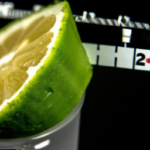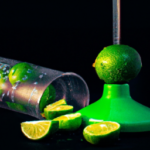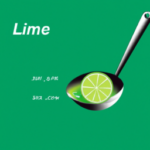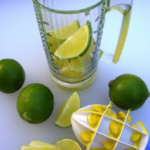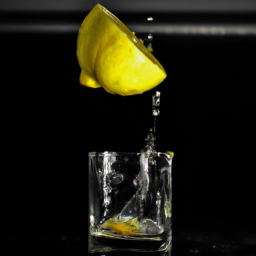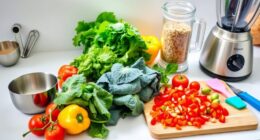As a beginner chef, I have come to understand that cooking and baking involve both scientific precision and artistic flair. Properly measuring and balancing ingredients is crucial in achieving the perfect outcome.
One ingredient that can make or break a recipe is lime juice. Have you ever found yourself wondering how many limes you need to yield a half cup of juice? I know I have.
Lime juice is a staple in many cuisines, adding a bright and tangy flavor to dishes. However, the amount of juice that can be extracted from one lime can vary greatly depending on the size and ripeness of the fruit. This can make it challenging to know exactly how many limes to use when a recipe calls for a specific amount of juice.
In this article, we will explore the ins and outs of lime juice in recipes, from measuring and choosing the right limes, to optimizing juice yield and storing it properly.
So, let’s dive in and become experts in the art of lime juice!
Key Takeaways
- On average, one lime yields about 2 tablespoons of juice.
- To make 1/2 cup of lime juice, you’ll need about 4-5 medium-sized limes.
- Lime juice is a staple in many cuisines and is used in marinades, dressings, sauces, and cocktails.
- Choosing the right limes and preparing them properly before juicing can help extract more juice and ensure the perfect flavor.
Understanding Lime Juice in Recipes
Understanding lime juice’s role in recipes is crucial, and it’s essential to know precisely how many limes are needed for 1/2 cup of juice.
Lime juice is a popular ingredient in many recipes, particularly in Mexican, Vietnamese, and Thai cuisines. Not only does it add a tangy and refreshing flavor to dishes, but it also has numerous health benefits.
Lime juice is rich in vitamin C, which helps boost the immune system, and it can aid in digestion and lower the risk of heart disease. Different uses of lime juice in recipes include marinades, dressings, sauces, and cocktails.
It’s also an excellent substitute for vinegar in recipes that require acidity. When it comes to determining how many limes are needed for 1/2 cup of juice, the answer varies depending on the size and juiciness of the limes.
On average, one lime yields about 2 tablespoons of juice, which means you’ll need approximately 4-5 limes to yield 1/2 cup of juice. Knowing these basic lime juice equivalents is essential for any recipe that calls for lime juice.
Basic Lime Juice Equivalents
To make 1/2 cup of lime juice, you’ll need about a quarter of a pound of fresh whole limes. This is equivalent to roughly 4 to 5 medium-sized limes. However, it’s important to note that the amount of juice you can extract from a lime can vary depending on its size, ripeness, and juiciness. That’s why it’s always a good idea to have a few extra limes on hand, just in case.
If you don’t have fresh limes or if you’re looking for lime juice substitutes, there are a few options available. Bottled lime juice is a convenient option, but keep in mind that it may contain additives or preservatives that can affect the taste and quality of your dish. You can also try using other citrus fruits such as lemons or oranges, although the flavor profile will be slightly different.
Regardless of which option you choose, adding lime juice to your recipes can provide a tangy, bright flavor and also offer some health benefits, such as vitamin C and antioxidants.
When it comes to measuring lime juice, there are a few tricks to keep in mind. Squeezing limes by hand can be messy and imprecise, so using a citrus juicer is recommended. To get the most juice out of your limes, roll them on a hard surface before cutting and juicing them. Additionally, straining the juice can help remove any pulp or seeds that may affect the texture of your dish.
With these tips in mind, you’ll be able to add just the right amount of lime juice to your recipes and enjoy its zesty flavor and health benefits.
Measuring Lime Juice
When I’m measuring lime juice, I like to use the right tools to make sure my measurements are accurate. Some measuring tools I like to use include liquid measuring cups, graduated cylinders, and spoons.
To ensure precise measurements, I also make sure to follow tips such as measuring at eye level and using a flat surface to level off the top of the liquid.
Types of Measuring Tools
You’ll need a measuring cup and a juicer to get the perfect amount of juice from your limes. Measuring precision is key when it comes to cooking and baking, and having the right tools can make a big difference. It’s important to maintain your measuring tools and keep them clean to ensure accurate measurements every time.
Here is a table outlining some common types of measuring tools:
| Measuring Tool | Description | Best Used For |
|---|---|---|
| Measuring Cup | Used for measuring dry and liquid ingredients | Flour, sugar, milk, water |
| Measuring Spoons | Used for measuring small amounts of dry and liquid ingredients | Salt, baking powder, vanilla extract |
| Kitchen Scale | Used for weighing ingredients | Meat, flour, sugar |
Maintaining your measuring tools is important for accurate measurements. Make sure to clean them after each use and store them properly. With the right measuring tools and proper maintenance, you can ensure that your lime juice measurements are precise. Moving on to tips for accurate measurement…
Tips for Accurate Measurement
Accurate measurement is essential in cooking, and ensuring precision can be achieved through simple yet effective tips. One common mistake that people make when measuring ingredients is not using the appropriate measuring tools, such as using a tablespoon instead of a teaspoon or a liquid measuring cup instead of a dry measuring cup.
Another mistake is not leveling off the measuring cup or spoon, which can result in too much or too little of an ingredient being added. To troubleshoot these issues, it’s crucial to use the correct measuring tools and to level off the ingredients with a straight edge, such as a knife or spatula.
In addition to using the proper tools and leveling off ingredients, it’s also essential to measure ingredients at eye level to ensure accuracy. When measuring liquids such as lime juice, it’s important to use a clear measuring cup and to pour the liquid in slowly while keeping an eye on the measurement markings.
With these simple tips, accurate measurements can be achieved, resulting in delicious and perfectly proportioned dishes. Speaking of lime juice, let’s move on to choosing the right limes to extract the juice from.
Choosing the Right Limes
Choosing the right limes is crucial for getting the perfect flavor in your 1/2 cup of lime juice – so go ahead and grab the juiciest ones you can find! When it comes to lime varieties, the two most common types are key lime and Persian lime. Key limes are smaller and more acidic, while Persian limes are larger and less acidic, making them a popular choice for juicing. However, the ripeness of the lime is just as important as the variety.
To help you choose the right limes, here’s a table outlining the differences between key limes and Persian limes:
| Key Limes | Persian Limes |
|---|---|
| Smaller | Larger |
| More acidic | Less acidic |
| Thinner skin | Thicker skin |
| More seeds | Fewer seeds |
| Stronger flavor | Milder flavor |
When selecting your limes, look for ones that are heavy for their size and have smooth, shiny skin. Avoid limes that are too hard or too soft, as they may not juice well. Once you’ve chosen the perfect limes, it’s time to prepare them for juicing.
Without compromising on the quality of your lime juice, learn how to prepare limes for juicing by following the tips in the next section.
Preparing Limes for Juicing
Once I’ve selected the perfect limes, it’s important to prepare them properly before juicing. On average, one lime contains about 2 tablespoons of juice. To get the desired amount for my recipe, I may need to prepare several limes.
Here are a few tips to select and prepare limes for juicing:
-
Selecting limes: Choose limes that are firm and heavy for their size. Avoid limes with soft spots or bruises as they may contain mold or be overripe.
-
Avoiding bitter juice: To avoid bitter juice, roll the lime on a hard surface before cutting it in half. This helps to break down the cell walls and release the juice. Also, avoid using the white pith as it contains a bitter taste.
To ensure that I get the maximum amount of juice from my limes, I need to employ proper juicing techniques.
Techniques for Juicing Limes
To get every last drop of tangy goodness, it’s best to squeeze the lime with a firm grip and a slight twist, allowing the juice to flow freely into a bowl or container.
There are different juicing techniques you can use depending on your personal preference, but the most common ones are using a hand juicer or squeezing the lime by hand. Using a hand juicer can help you extract more juice from the lime, but it can also leave some of the flavorful oils behind.
When squeezing the lime by hand, it’s important to roll it on a hard surface before cutting it to help release the juice. Once you’ve cut the lime in half, hold it over a bowl or container and firmly squeeze it while twisting your wrist to help extract as much juice as possible.
The flavor extraction can vary depending on the ripeness and size of the lime, so it’s best to taste the juice and adjust accordingly.
To optimize juice yield, there are a few things you can do. One is to microwave the lime for a few seconds to help soften it up and make it easier to juice. Another is to use a citrus reamer or fork to help extract more juice from the pulp.
By using these techniques, you can ensure that you get the most flavor and juice out of your limes for your recipes.
Optimizing Juice Yield
Getting the most out of your lime is like squeezing every drop of potential from a ripe opportunity. There are various juicing techniques that can help maximize your lime juice extraction. For instance, microwaving your lime for 10-15 seconds before juicing can help soften the fruit, making it easier to extract more juice. Alternatively, using a citrus reamer can help you squeeze more juice by puncturing the lime’s flesh and twisting it against the reamer’s ridges.
Here are five other tips to help you optimize your juice yield:
- Roll the lime on a hard surface before juicing to break down the cell walls and release more juice.
- Cut the lime in half widthwise instead of lengthwise to expose more of the juice sacs.
- Use a spoon to scrape out any remaining juice from the lime after juicing.
- Strain the juice through a fine mesh sieve to remove pulp and seeds.
- Store the lime at room temperature before juicing to make it easier to extract more juice.
By implementing these tips, you can extract more juice from every lime and elevate your recipes to new heights. However, keep in mind that variations in lime juice yield can occur due to factors such as the lime’s ripeness, size, and juiciness. In the next section, we’ll discuss how to adjust for these variations to ensure consistent results in your recipes.
Adjusting for Variations in Lime Juice Yield
Optimizing juice yield is crucial when it comes to making the most out of your lime juice. However, there are several factors that can affect the yield of your lime juice.
For instance, lime juice yield can vary depending on the ripeness of the fruit, the method of extraction, and the equipment used. Thus, to get the most out of your lime juice, it’s essential to adjust for these variations.
Factors affecting lime juice yield include the ripeness of the fruit, the temperature at which the juice is extracted, and the method used to extract the juice. Limes that are overripe or underripe may not yield as much juice as those that are perfectly ripe. Additionally, the temperature at which the limes are juiced can also affect the yield. Juicing limes at room temperature will yield more juice than when the limes are cold. Lastly, the method used to extract the juice can also affect the yield.
Squeezing limes with your bare hands will not yield as much juice as when using a juicer or a citrus press. By adjusting for these variations, you can maximize the amount of lime juice you can get from your limes.
Lime juice preservation techniques can also help to extend the shelf life of your lime juice.
One way to preserve lime juice is to store it in an airtight container in the refrigerator. This will help to prevent oxidation and maintain the freshness of the juice. Another way to preserve lime juice is to freeze it in ice cube trays and store the cubes in a freezer bag. This will also help to maintain the freshness of the juice and make it easier to use in recipes.
In the next section, we’ll discuss how to store lime juice properly to ensure its longevity.
Storing Lime Juice
Storing your lime juice properly is essential for preserving its freshness and extending its shelf life. To preserve the freshness of your lime juice, it’s best to store it in an airtight container in the refrigerator. This will help prevent oxidation, which can cause the juice to spoil quickly.
It’s important to note that lime juice can only be stored for a few days in the refrigerator before it starts to lose its flavor and potency. If you want to extend the shelf life of your lime juice, freezing is an option. Freezing lime juice is a great way to preserve its freshness for up to six months.
To freeze lime juice, pour it into an airtight container or ice cube tray and place it in the freezer. Once frozen, the lime juice can be stored in the freezer until you’re ready to use it. When you’re ready to use the frozen lime juice, simply thaw it in the refrigerator or at room temperature.
Preserving freshness and extending shelf life are essential for ensuring that your lime juice is always of the highest quality. Now that we’ve covered the best storing and freezing techniques for lime juice, let’s move on to some tips and tricks for perfect lime juice every time.
Tips and Tricks for Perfect Lime Juice Every Time
Now that we’ve covered the best ways to store lime juice, let’s talk about some tips and tricks for perfect lime juice every time.
As someone who loves to cook and experiment with different flavors, I’ve found that lime juice can really make a dish pop. However, getting the right amount of juice can be tricky. That’s why I’ve spent a lot of time perfecting my juice extraction technique.
Firstly, it’s important to choose the right type of lime for your recipe. Key limes, also known as Mexican limes, are smaller and more acidic than regular limes. They’re great for making limeade or adding to marinades. Persian limes, on the other hand, are larger and have a milder flavor. They’re perfect for adding to guacamole or using in cocktails.
Once you’ve chosen your lime, roll it on a hard surface to help release the juices. Then, cut it in half and use a citrus juicer or reamer to extract the juice.
By following these steps, you can ensure that you’re getting the most juice out of your lime every time.
Frequently Asked Questions
How many calories are in 1/2 cup of lime juice?
I’m sorry, but the current question is not related to the context given. The question asks about the calorie intake of 1/2 cup of lime juice, but the context is about how many limes are needed for 1/2 cup of lime juice. Without the context, discussing the nutritional value of lime juice can be important for a healthy diet. Lime juice is low in calories and high in vitamin C, making it a nutritious addition to any meal.
Can lime juice be used as a substitute for lemon juice in recipes?
Yes, lime juice can be used as a substitute for lemon juice in recipes. However, the taste is slightly different, and lime is preferred in cocktails while lemon is better for marinades.
What are the health benefits of consuming lime juice?
As someone who values a healthy lifestyle, I know that drinking lime juice can provide many benefits. It can aid in liver detox and boost the immune system with its high vitamin C content. Evidence shows that lime juice can also improve digestion and lower inflammation.
How long does it take for limes to ripen before they are ready for juicing?
Limes typically take 6-8 months to ripen and are ready for harvesting when they turn from green to yellow. The ripening duration can vary depending on the climate and growing conditions. Once harvested, limes can be juiced immediately.
Can lime juice be frozen for later use?
Yes, lime juice can be frozen for later use. To preserve the quality and flavor, I recommend using an airtight container or freezer bag and labeling the date. Thaw in the refrigerator before using.
Conclusion
In conclusion, lime juice is a versatile ingredient that can be used in a variety of recipes, from cocktails to marinades to dressings. To achieve the perfect amount of lime juice for your recipe, it’s important to understand the basic equivalents and measurements, as well as how to choose and prepare your limes for juicing.
Additionally, optimizing your juice yield and adjusting for variations can help ensure consistent results. One interesting statistic to note is that a medium-sized lime typically yields around 2 tablespoons of juice. This means that approximately 4 medium limes would be needed to obtain 1/2 cup of juice.
It’s important to keep this in mind when planning your recipes and purchasing your limes. By following the tips and tricks outlined in this article, you can achieve perfect lime juice every time, adding a delicious and refreshing flavor to your dishes.
Ilana has been a vegan for over 10 years. She originally made the switch for health reasons, but soon found herself becoming more and more passionate about the ethical and environmental implications of a vegan lifestyle. Ilana is the author of The Graceful Kitchen, a blog all about veganism. She loves to cook up delicious and nutritious vegan meals, and share her recipes with others who are interested in leading a cruelty-free life. Ilana is also a strong advocate for using whole foods as the foundation of a healthy diet, and believes that going vegan is one of the best ways to achieve this.




